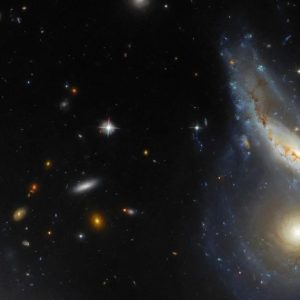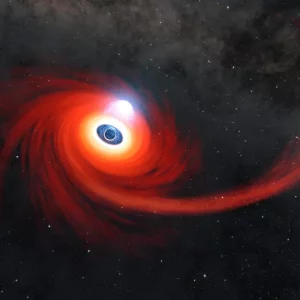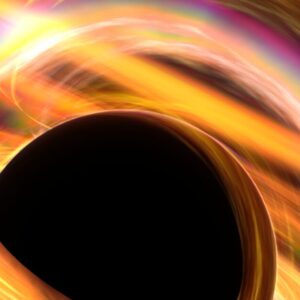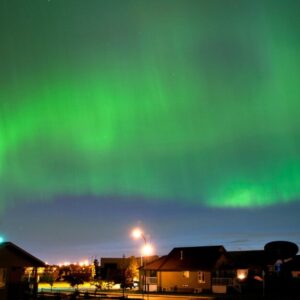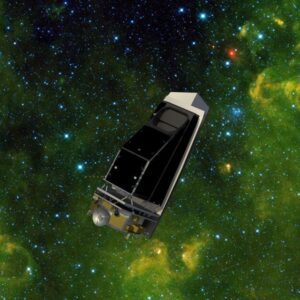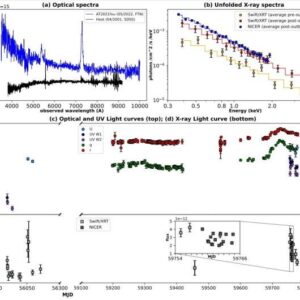NASA’s Hubble Space Telescope has imaged a Spider Galaxy, known as UGC 5829, located approximately 30 million light-years away from us. This irregular galaxy is named the ‘Spider Galaxy’ for its close resemblance to the limbs of a spider. The stunning view of the Spider Galaxy has depicted the grandeur...
Diary
The Hubble Space Telescope has captured another captivating image of Arp 122, a peculiar galaxy undergoing a monstrous merger. This cosmic collision involves two galaxies – NGC 6040, a tilted, warped spiral, and LEDA 59642, a round, face-on spiral, at a distance of approximately 570 million light-years from Earth. Galactic...
NASA’s James Webb Space Telescope recently identified a second supernova within a distant galaxy, MACS J0138.0-2155, refueling the debate surrounding the universe’s expansion rate. This discovery, observed in November 2023, utilizes the gravitational lensing effect, bending light due to intense gravity, leading to multiple images of the galaxy. Astronomers stumbled...
AT2022aedm, discovered by astronomers using the ATLAS network of robotic telescopes approximately 2 billion light-years away from Earth, is unlike any other explosions that we routinely observe.
In a few more hours, India will become the fourth country to make a soft-landing on Moon, with Chandrayaan-3, the country’s third lunar mission, scheduled to land on the Moon’s South Pole at 6:04pm(IST) today, 23 August.
Prevailing theories suggest that black holes are objects so massive that nothing can escape the pull of their gravity, not even light. They form when enormous stars run out of fuel and collapse in on themselves. And, for decades, the paradox surrounding black holes is that as black holes evaporate,...
The most powerful solar storm in nearly six years, catching forecasters by surprise, slammed into Earth on March 24, 2023, peaking as a severe G4 on the 5-grade scale used by the U.S. National Oceanic and Atmospheric Administration (NOAA) to assess the severity of space weather events. The recent storm’s...
Turning to Artificial Intelligence (AI) to design mission hardware is becoming increasingly popular among NASA projects as AI-designed parts are lighter, more structurally sound, and can be designed much quicker than with traditional methods. Ryan McClelland, a research engineer at NASA’s Goddard Space Flight Center, Greenbelt, Maryland, has pioneered the...
Construction of NASA’s next-generation asteroid hunter, Near-Earth Object Surveyor (NEO Surveyor), has begun.
AT2021fxu is a changing-look active galactic nucleus (AGN). By analyzing data from NASA’s Swift spacecraft and NICER on the International Space Station, astronomers have revealed its true nature. According to the results of the study, published on December 14 on the arXiv preprint server, deliver important insights into the nature...
A suborbital trip on Virgin Galactic’s SpaceShipTwo and Blue Origin’s New Shepard typically costs $250,000 to $500,000. Flights beyond that to actual orbit—a much higher altitude—fetch more than $50 million per seat. A trip to space is very expensive and only affordable to those who can pay a large amount...
On average, the Moon’s distance from Earth is 238,855 miles, or 384399.8611 kilometers, or 384399861.1 meters. Yes, the average distance, because the Moon’s orbit is not perfectly circular, and its reach from Earth varies. At its furthest point from Earth, the Moon is 252,700 miles (406681.2288 km) away. When the...
Definition of an Exoplanet An exoplanet is a planet that orbits a star and is outside of our solar system. Earth-like exoplanets are of particular interest to astronomers because they may be able to support life. NASA has discovered thousands of exoplanets using the Kepler Space Telescope and is currently...
Introduction A solar eclipse means Moon blocking the Sun from view. There are 3 types of solar eclipses: total, partial, and annular. •Total solar eclipses are when the Moon completely covers the Sun. The Moon’s shadow is cast on Earth. •Partial solar eclipses are when the Moon covers part of...
International Dark-Sky Association is an organization that works to reduce light pollution. It was founded in 1988, and since then, it has been working to raise awareness of the issue and lobby for changes to reduce light pollution. In recent years, there has been an increase in awareness of light...
